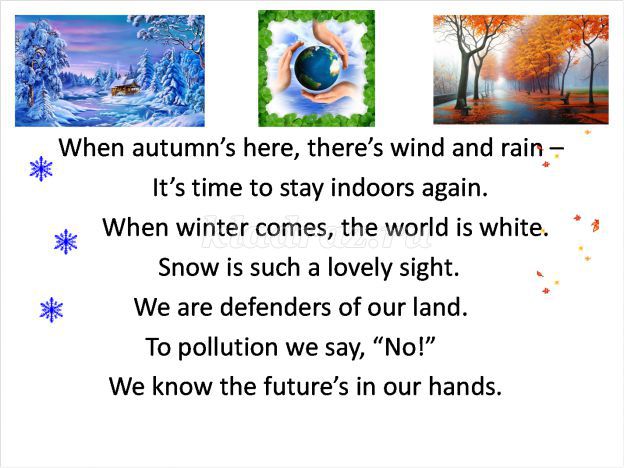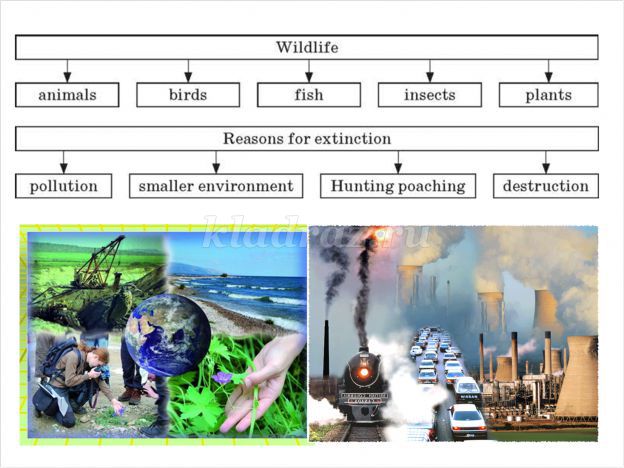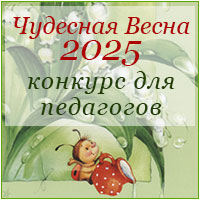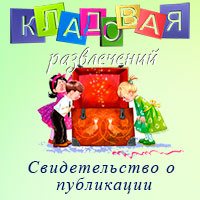Конспект урока английского языка с презентацией, 7 класс. Природа. Береги планету
Конспект урока английского языка “Природа. Береги планету" для 7 класса c презентацией

Должность, место работы: учитель английского языка 1 квалификационной категории ДОШ№ 62
Описание материала: Предлагаю Вам конспект урока по теме "Природа. Береги планету" для учащихся 7 класса общеобразовательной школы. Данный материал будет интересен учителям английского языка. Коммуникативные упражнения, стихотворения, тексты о редких животных помогут разнообразить Ваш урок.
Тема: Природа. Береги планету.
Цель: экологическое воспитание учащихся и развитие коммуникативной компетенции.
Задачи: научить учащихся выражать свою точку зрения, используя новую лексику в речи; расширить кругозор учащихся о причинах экологического загрязнения, редких видах животного мира; развивать навыки говорения, письма, чтения, аудирования; развивать память, мышление, внимание, уважительное отношение к мнению собеседника; воспитывать культуру общения, бережное отношение к окружающему миру.
Тип урока: комбинированный
Оборудование: учебник, раздаточный материал, фотографии животных.
Ход урока
1. Организационная часть.2. Фонетическая зарядка (стихотворение “Nature”).
3. Речевая зарядка.
4. Проверка домашнего задания. (Краткое сообщение о любимом виде животного).
5. Изучение нового материала.
а) Введение новой лексики и ёё использование в речи.
б) Обсуждение причин экологического загрязнения и путей решения экологических проблем.
6. Закрепление материала (тексты о редких видах животных для чтения и аудирования, выполнение упражений).
7. Подведение итогов.
8. Домашнее задание: подготовить диалог о редких видах животных.
Procedure
1. Starting point. Greeting.
2. Phonetic drill
(the poem “Nature”).

3. Warm-up.
Teacher: Any season has got its peculiarities. What is your favourite season?Pupil 1: I like summer because the weather is sunny and hot. I usually go to the seaside in August. I like to swim, lie in the sun, play volleyball and other games with our friends in summer. That’s why summer is my favourite season.
Pupil 2: My favourite season is winter. The weather is usually snowy. I like to play hockey, snowballs, make a snowman and skate. That’s why winter is my favourite season.
Pupil 3: I like early autumn very much. The leaves turn from green to orange, red and brown. The golden autumn looks like a fairy-tale. That’s why autumn is my favourite season.
Pupil 4: As for me, I like spring. The snow begins to melt and everything becomes green. The days get longer. Different colouful flowers begin to bloom. I like to go for a walk in the forest, parks in spring.
Teacher: How do you understand the following lines:
From plankton to whales,
All life great and small
Depends on each other.
Life’s web links us all.
Pupil 5: Animals, plants and people are one part of this great world. What we need is a healthy environment.
4. Checking up home-assignment
Teacher: Tell us about your favourite animals.Pupil 1: My favourite animal is a walrus. It spends almost all its life in the water. It leaves water only to warm itself in the sun, to rest and sleep. The walrus is protected against cold with a thick layer of fat under its skin. The walrus swims fast and dives for fish.
Pupil 2: My favourite animals are dolphins and whales. A dolphin is as big as a shark. It is not a fish. It is a mammal. Dolphins feed their babies with milk. Some dolphins can travel at 55.5 kilometres per hour.The biggest water animal is a whale. Some whales weigh several tons. They are mammals too.
Pupil 3: It is interesting to know that there is a fish which can climb a tree. That’s why its name is the climbing perch. It can climb a tree, though not very high. If the water dries up in the pond where the climbing perch lives, it can crawl to another pond that has water in it. I like to go fishing. I also prefer watching TV programmes about water animals.
Pupil 4: My favourite animal is a reindeer. They are very beautiful. The reindeer have to travel for great distances to find their food. They usually migrate in small groups around the tundra. In summer the reindeer keep nearer to the shores of the Arctic Ocean. In autumn they migrate to the South where there is more food for them.
5.The main part
Lexical practice ( extinct, extinction, wildlife, destroy, rare,to be contaminated with toxic wastes, soil pollution, water and air pollution, deforest, species).Writing
Teacher: Practise the new vocabulary and fill in the gaps (Extinct, extinction, wildlife, destroy, rare)
1) Animals and plants growing in natural conditions are called….
2) The members of this organization are trying to save the whale from...
3) The world’s climate will change if we…the rainforests.
4) These plants are very…
5) Some species of plants and animals … every year.
(Key: 1.wildlife, 2.extinction, 3.destroy, 4.rare, 5.extinct)
Speaking
Teacher: The Earth is our home. Look at the diagram and say why wildlife is in danger. What can be done to save wildlife?

Pupil 2: Soil, water and air are contaminated with toxic wastes. Air and water pollution can kill a lot of animals and plants. We are paying for this pollution with our health too.
Pupil 3: Cutting down the trees is another reason of environmental pollution. We should remember that the air protects the Earth against space radiation.
Pupil 4: To solve this problem, I believe, it is necessary to raise safety standards at all industrial facilities and to stop cutting down the trees.
Pupil 5: People should stop hunting animals. Killing animals is like killing people because we are all living creatures. We all feel pain. I think animals should be protected by us.
Pupil 6: Some people like to pick up flowers in the forest. That’s why a lot of flowers become rare. It is better to draw flowers or take pictures.
Pupil 7: It is necessary to be very careful in the forest, especially when the weather is dry and windy. We should not drop burning matches, extinguish the bonfire carefully.
6. Reading/Speaking
Teacher: Read some texts about endangered animals and retell them in groups. Endangered animals
The Siberian tiger is also known as the Amur tiger. It is written in the Red book. There were about 450 tigers in 1996. The Siberian tiger population had increased to 540 individuals in the Russian Far East by 2015. The Siberian tiger is one of the biggest animals. Its length is about 2metres. Its mass is about 350 kg. It runs fast. The Siberian tiger rarely becomes a man-eater. The white tiger is a pigmentation variant of the Bengal tiger, which is reported in the wild from time to time in the Indian states of Assam, Bengal, Bihar. The white Bengal tigers are distinctive due to the colour of their fur. The stripes are unique to each tiger. The patterns are not the same. Their eyes are blue in colour, instead of the regular yellow or green. They also have a better night vision. People should save this animal for the future!
The snow leopard lives in Central Asia. It is found in the following countries: Russia, Mongolia, Tibet, China, India, Pakistan, and Afghanistan. It hunts at night . It can jump very well. The snow leopard can see and hear perfectly. If it sees a man, it escapes and hides. The fur coat of the snow leopard is of great value. That is why hunters kill it very often. Save it for the Earth and our nature!
One of the American animals which do not occupy huge area is the puma. This mountain lion is the largest animal of the fauna of America. The puma has a strong body, a small head, strong legs, a long tail. The puma runs and climbs trees very quickly . It swims well. The puma is also an endangered animal!
The blue-throated macaw is also known as Caninde macaw or Wagler's macaw. It lives in Bolivia. It is currently considered critically endangered and the parrot is protected by trading prohibition. These birds are active during the day and usually stay in one general area. These parrots communicate mostly by sound. When they suspect danger, they emit a very loud alarming call and fly off.
The brown spider monkey is endangered. It lives in the forests in northern Colombia and northwestern Venezuela. The brown spider monkey has a whitish belly and patch on the forehead. The eyes are sometimes pale blue. These monkeys spend most of their time high in trees. They travel mostly by swinging and climbing between trees.
Listening
Teacher: Listen to the song of Louis Armstrong. Choose the correct alternatives.
What a wonderful world
I see trees of green, pink \ red roses too
I see them bloom for me and for you
And I think to myself, what a wonderful world.
I see seas\ skies of blue and clouds of white
The beautiful day, the beautiful night\light
And I think to myself , what a wonderful world.
The colours of the rainbow
So pretty/beautiful in the sky
Are also on the faces of the people going by
I see friends shaking hands saying, ‘How do you do?’
They're really saying, ‘I love you’.
I hear babies\ children cry, I watch them grow
They'll learn much more than I'll never know
And I think to myself, what a wonderful world
Yes, I think to myself, what a wonderful world.
7. Summing up
8.Home-assignment
Teacher: Make up dialogues about endangered animals.
Презентация на тему: Природа. Береги планету
Рекомендуем посмотреть:
 Конспекты уроков по английскому языку по теме: Традиции и обычаи, 7 класс
Конспекты уроков по английскому языку по теме: Традиции и обычаи, 7 класс
 План-конспект урока английского языка для 7 класса с презентацией. Американские президенты, Джордж В
План-конспект урока английского языка для 7 класса с презентацией. Американские президенты, Джордж В
 Русские народные сказки, как средство развития дошкольников 4-5 лет
Русские народные сказки, как средство развития дошкольников 4-5 лет
 Коммуникативный подход обучения на уроках английского языка. Тема "Природа. Защита окружающей среды"
Коммуникативный подход обучения на уроках английского языка. Тема "Природа. Защита окружающей среды"
Участник №7 творческого конкурса «Кладовая природы» с 3 апреля по 3 сентября 2016 года
← Викторина по английскому языку для 4 класса с презентацией | Сказка для младших школьников «Путешествие в волшебный мир английского языка» →
|
|
Автор: Марина Сергеевна Долгих
Опубликовано: 3285 дней назад (30 марта 2016)
Просмотров: 8259
Рубрика: Без рубрики
|
+31↑ Голосов: 31 |
| 15 апреля 2016 в 19:14 +1 | ||
|
| 15 апреля 2016 в 19:36 +5 | ||
|
| 15 апреля 2016 в 20:18 +4 | ||
|
| 15 апреля 2016 в 21:41 +5 | ||
|
| 15 апреля 2016 в 22:32 +3 | ||
|
| 16 апреля 2016 в 10:23 +4 | ||
|
| 16 апреля 2016 в 12:07 +4 | ||
|
| 16 апреля 2016 в 12:36 +4 | ||
|
| 16 апреля 2016 в 13:30 +2 | ||
|
| 16 апреля 2016 в 13:31 +4 | ||
|
| 16 апреля 2016 в 13:32 +3 | ||
|
| 16 апреля 2016 в 15:46 +3 | ||
|
| 16 апреля 2016 в 21:42 +2 | ||
|
| 16 апреля 2016 в 22:46 +2 | ||
|
| 17 апреля 2016 в 01:21 +3 | ||
|
| 17 апреля 2016 в 11:00 +2 | ||
|
| 18 апреля 2016 в 20:37 +3 | ||
|
| 18 апреля 2016 в 21:05 +1 | ||
|
| 19 апреля 2016 в 16:31 +1 | ||
|
| 19 апреля 2016 в 19:15 +2 | ||
|
| 19 апреля 2016 в 21:07 +1 | ||
|
| 21 апреля 2016 в 19:49 +2 | ||
|
| 23 апреля 2016 в 00:21 +4 | ||
|
| 23 апреля 2016 в 17:24 +2 | ||
|
| 26 апреля 2016 в 15:12 +2 | ||
|
| 26 апреля 2016 в 18:32 +2 | ||
|
| 26 апреля 2016 в 21:34 +4 | ||
|



 Работа мне Ваша нравится! Хорошее оформление и содержание уверена познавательное! Мой голос +1
Работа мне Ваша нравится! Хорошее оформление и содержание уверена познавательное! Мой голос +1 

